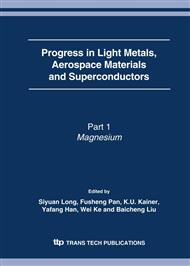p.1171
p.1179
p.1187
p.1195
p.1201
p.1207
p.1211
p.1219
p.1225
Effects of Ru Additions on the Microstructures and Stress Rupture Life of a Directionally Solidified Ni-Based Cast Superalloy
Abstract:
Two directionally solidified (DS) Ni-based cast superalloys without and with 3wt. % Ru were prepared. The effects of Ru addition on the microstructures and stress rupture properties of the heat treated superalloys were investigated. It is shown that the amount of eutectic in 3wt. % Ru alloy was less than that in alloy without Ru. The incipient melting structure was found after quenching followed by 1295°C and 1300°C solid solution treatments in 3wt. % Ru alloy and in the alloy without Ru, respectively. The temperature at which the eutectic pools dissolved completely was higher than the temperature at which incipient melting appears. In order to obtain the better mechanical properties, double aging treatment was carried out for both alloys to optimize the sizes, morphologies and distribution of the γ′ phase. The stress rupture lives of the alloys were 55h and 108h under the condition of 1070°C and 137MPa the alloys without Ru and with 3wt. % Ru respectively. It is suggested that 3wt. % Ru addition can prolong the stress rupture life of the alloy.
Info:
Periodical:
Pages:
1201-1206
Citation:
Online since:
May 2007
Authors:
Price:
Сopyright:
© 2007 Trans Tech Publications Ltd. All Rights Reserved
Share:
Citation:


